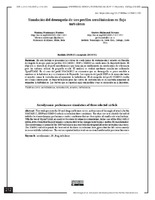Mostrar el registro sencillo del ítem
Simulación del desempeño de tres perfiles aerodinámicos en flujo turbulento
| dc.contributor.author | Montenegro-Montero, Mariana | |
| dc.contributor.author | Richmond-Navarro, Gustavo | |
| dc.date.accessioned | 2022-02-16T17:19:34Z | |
| dc.date.available | 2022-02-16T17:19:34Z | |
| dc.date.issued | 2021 | |
| dc.identifier.uri | https://hdl.handle.net/2238/13488 | |
| dc.description | UNIVERSIDAD, CIENCIA y TECNOLOGÍA Vol. 25, Nº 111 Diciembre 2021(pp. 212-225) | es |
| dc.description.abstract | En este trabajo se presentan las curvas de coeficientes de sustentación y arrastre en función del ángulo de ataque, para los perfiles NACA0012, S809 y SG6043 en condiciones de flujo turbulento. El objetivo es identificar el perfil aerodinámico que tiene mejor rendimiento en condiciones de relevancia para las turbinas eólicas de pequeña escala. El análisis se realizó mediante simulación utilizando OpenFOAM. En el caso del perfil NACA0012 se encuentra que su desempeño es poco sensible a cambios en la turbulencia y en el número de Reynolds. La respuesta del perfil S809 es de aumentar tanto el arrastre como la sustentación al aumentar la turbulencia. El desempeño del perfil SG6043 resulta ser el más conveniente en flujo turbulento pues las curvas de sustentación en su mayoría aumentan al aumentar la turbulencia. Las curvas que se reportan aquí son inéditas y no se encuentra en la literatura. | es |
| dc.description.abstract | This work presents the lift and drag coefficient curves, as functions of the angle of attack, for the NACA0012, S809 and SG6043 airfoils in turbulent flow conditions. The objective is to identify the airfoil with the best aerodynamic performance under conditions that are descriptive of small scale wind turbine. With the use of OpenFOAM, an analysis was done by numerical simulation. In the case of the NACA0012 airfoil, it was found that the performance is insensitive to the changes in turbulence and the Reynold number. The aerodynamic response of the S809 airfoil is to increase both the drag and lift as the turbulence increases. The SG6043 airfoil responds the best out of the three in turbulent flow, given that the lift curves mostly increase with the turbulence. The curves reported in this work are new and not found in previous literature. | es |
| dc.language.iso | spa | es |
| dc.publisher | UNIVERSIDAD, CIENCIA y TECNOLOGÍA | es |
| dc.rights | acceso abierto | es |
| dc.rights.uri | http://creativecommons.org/licenses/by/4.0/ | * |
| dc.subject | Aerodinámica | es |
| dc.subject | Sustentación | es |
| dc.subject | Turbulencia | es |
| dc.subject | Flujo turbulento | es |
| dc.subject | Turbinas eólicas | es |
| dc.subject | Simulación | es |
| dc.subject | Aerodynamics | es |
| dc.subject | Lift | es |
| dc.subject | Turbulence | es |
| dc.subject | Turbulent flow | es |
| dc.subject | Wind turbines | es |
| dc.subject | Simulation | es |
| dc.subject | Research Subject Categories::TECHNOLOGY | es |
| dc.subject | Energía eólica | |
| dc.subject | Wind power | |
| dc.title | Simulación del desempeño de tres perfiles aerodinámicos en flujo turbulento | es |
| dc.type | artículo original | es |
| dc.identifier.doi | doi: https://doi.org/10.47460/uct.v25i111.532 |
Ficheros en el ítem
Este ítem aparece en la(s) siguiente(s) colección(ones)
-
Artículos [6]



